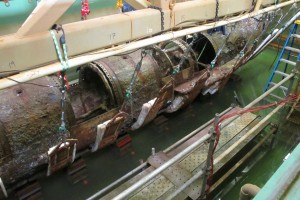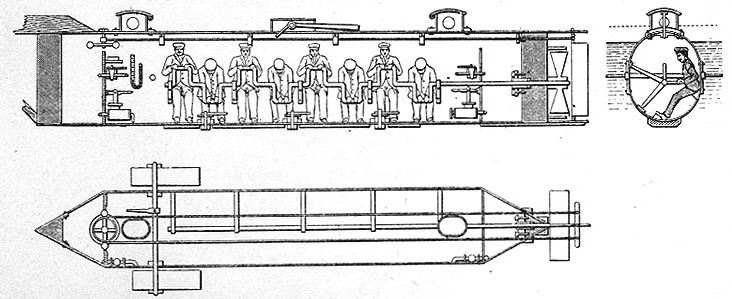 After more than a decade spent trussed in a cradle on her starboard side, the Civil War submarine H.L. Hunley is upright for the first time since she sank under mysterious circumstances off the coast of Charleston, South Carolina on February 17, 1864. She was raised in 2000 from the Atlantic floor at a 45-degree angle, the position in which she was found, and kept in 30 slings at that same angle in a conservation tank ever since.
After more than a decade spent trussed in a cradle on her starboard side, the Civil War submarine H.L. Hunley is upright for the first time since she sank under mysterious circumstances off the coast of Charleston, South Carolina on February 17, 1864. She was raised in 2000 from the Atlantic floor at a 45-degree angle, the position in which she was found, and kept in 30 slings at that same angle in a conservation tank ever since.
Engineers were concerned that moving the 7-ton, 40-foot vessel upright would put unbearable stress on the rusted iron keel. They weren’t sure what they’d find on the starboard side which had been buried in the sand for 136 years and then obscured from view by the angle. In order to properly conserve the ship, however, they had to have access to that starboard side. The conservation team thus spent two years planning and testing how best to rotate the vessel without harming it, using 3D computer modelling to simulate the procedure.
The straps that were holding the Hunley in place were replaced one at a time with slings that had hand controls allowing for tiny movement so the team could lower the port side gradually until the sub was upright. On Wednesday, June 22, engineers and conservators began rotating the submarine, adjusting the slings by two millimeter increments to shift it gradually upright.
The process to rotate the sub was at times slow and tedious and others nerve-racking. The painstaking project took three days, with scientists rotating the submarine mere millimeters at a time. After each incremental move, a series of computer monitors were checked to ensure even weight distribution with no major stresses on the submarine.
Two technical issues added hours, and a little tension, to the project. At one point, the bow started to dip too much toward the ground and scientists had to make modifications to get the submarine level again. They had anticipated the potential of this occurring though had hoped it would not affect the rotation.
Also, a laser monitoring system – critical to detecting any potential warping or damage that scientists were desperately trying to avoid – had to be adjusted one morning, causing a delay of a few hours for rotation work to start.
Even with the technical glitches, the laser never strayed more than a millimeter out of its target range, which is a remarkably successful result even for automation, never mind for a rotation process that relied entirely on humans winching 30 slings for three days.
Behold the raising of the Hunley in neat-o time-lapse video:
[kml_flashembed movie="http://www.youtube.com/v/5v2cBAkCHHU" width="425" height="350" wmode="transparent" /]
For the first time scientists are now able to examine the starboard side for indications of why and how the submarine sank right after successfully torpedoing the USS Housatonic, a Union warship enforcing the blockade of Charleston harbor, making the Hunley the first sub to sink an enemy ship in combat. There are large hull breaches on the starboard fin, as expected, and it is smooth-sided and shiny instead of encased in concretions like the port side. We don’t know yet if the breaches are man-made or the result of ocean and sand erosion or a combination of both.
Next week the team will lower the Hunley onto keel blocks on the way to eventual removal of the slings and truss that have kept the sub suspended for 11 years. Once the slings are gone, conservators will be able to remove all the concretions that coat the hull in preparation for a chemical bath that will restore the vessel’s iron hull.
The H.L. Hunley was a hand-powered submarine designed by Horace Lawson Hunley, James R. McClintock and Baxter Watson. Mr. Hunley sponsored her construction in 1863. She sank while moored to a steamer on August 29, 1863, killing five members of her crew, but was salvaged and put back to work on diving trials. This time Horace Lawson Hunley was on board and when she failed to surface after a trial on October 15, 1863, he died along with the rest of the crew.
The tragedies did not deter the Confederate navy. They fished her up again and repaired her, this time ordering the crew to remain on the surface instead of diving. It actually worked, and the Hunley made her historic hit, sinking the USS Housatonic with a spar torpedo. Then something went wrong and the submarine went down for her big sleep. The remains of her crew were recovered and buried in 2004.
